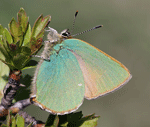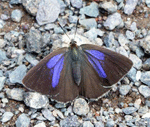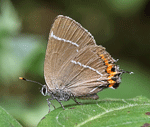There are five species of hairstreak butterfly in the UK. Hairstreaks are particularly at risk of habitat destruction, especially from development and changes in farming practices. The Oxford and Ampthill Clays are the only place in the UK where all five hairstreak butterflies naturally occur. This unique habitat needs to be protected to ensure all of these butterflies have a future.
The Black Hairstreak and Brown Hairstreak have faced losses due to inappropriate hedgerow and woodland edge management. The White-letter Hairstreak has suffered due to Dutch Elm Disease. Even the more common Purple Hairstreak and Green Hairstreak have suffered declines in recent years.
Hairstreaks are difficult to survey. Surveying either involves looking for small dark butterflies in trees during the summer, or searching for eggs on blackthorn in the winter. A new method of surveying using ultra-violet light has been developed. When UV light at a wavelength of 365nm (or 395nm) is shone on hairstreak larvae, they photoluminesce, making them much more visible. This should make surveying for hairstreaks quicker and easier.
BBOWT, in partnership with other organisations including Butterfly Conservation, has funding for a landscape-scale conservation partnership called Reconnecting Bernwood, Otmoor and the Ray (RBOR) which aims to work with communities, farmers and landowners to restore habitat for threatened species - including hairstreaks. This project is due to run from 2027 to 2032.
|







